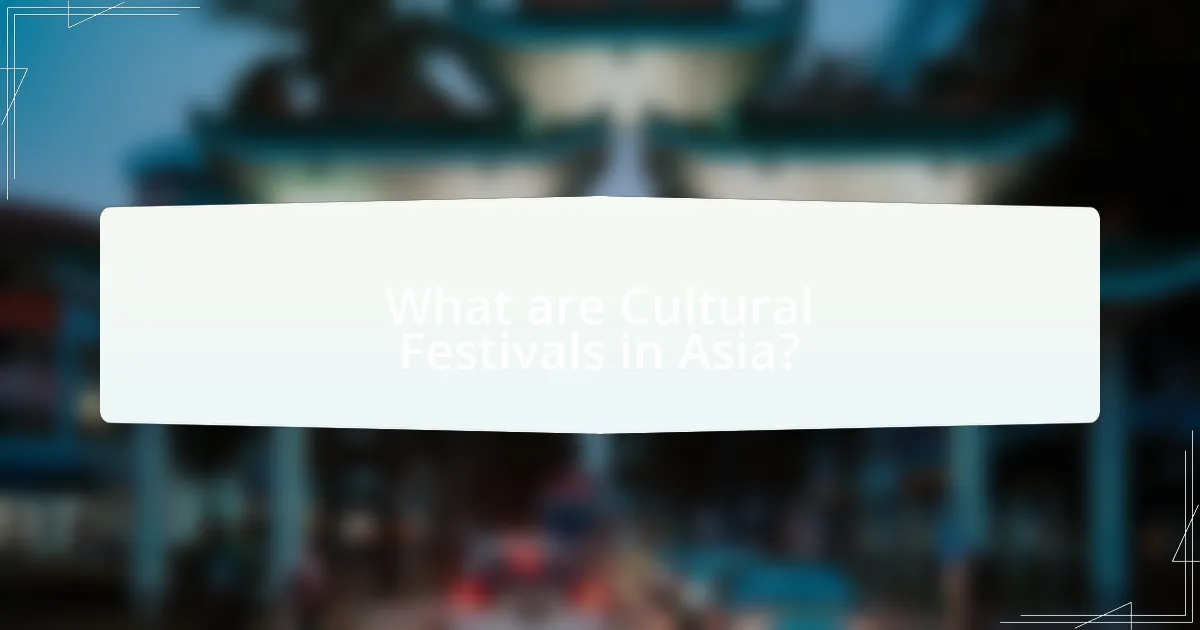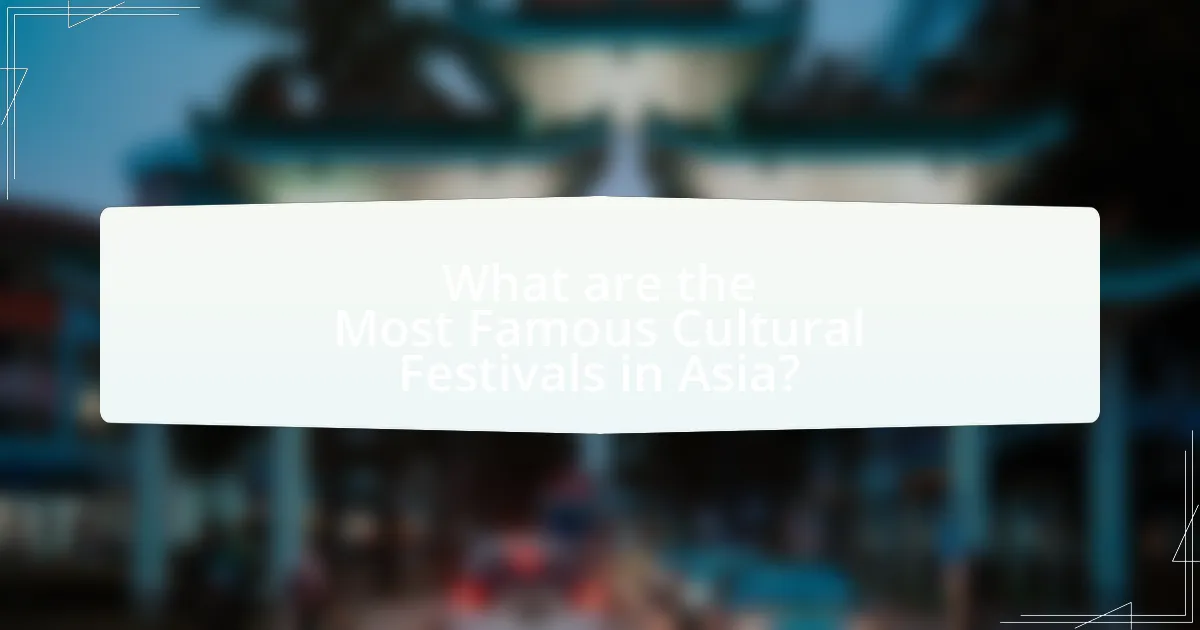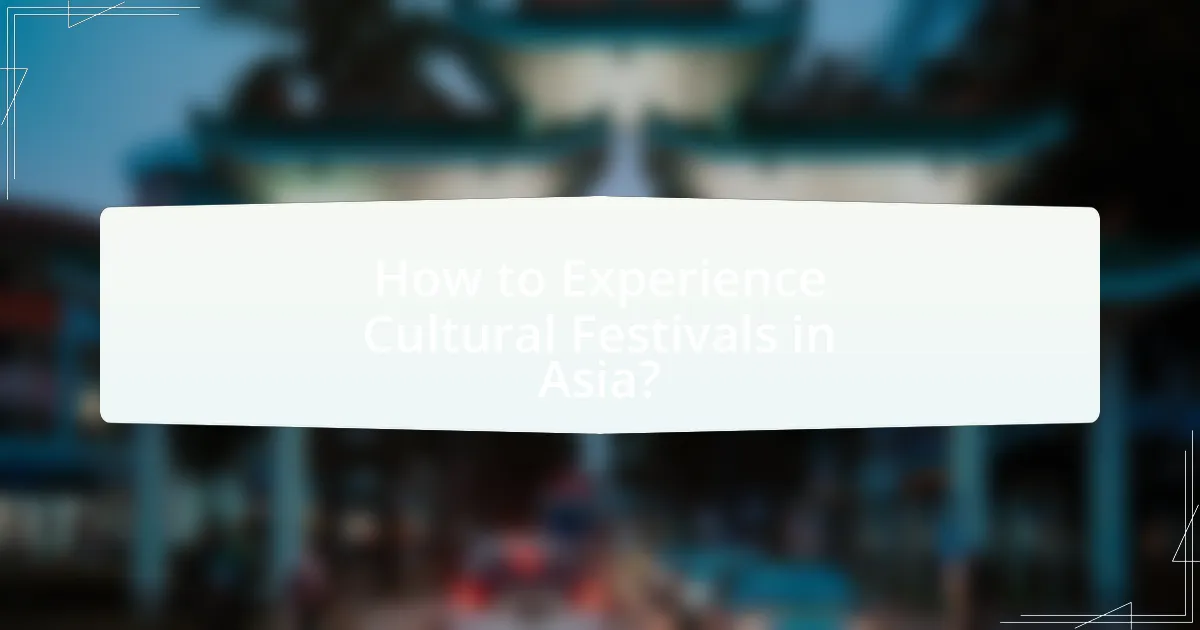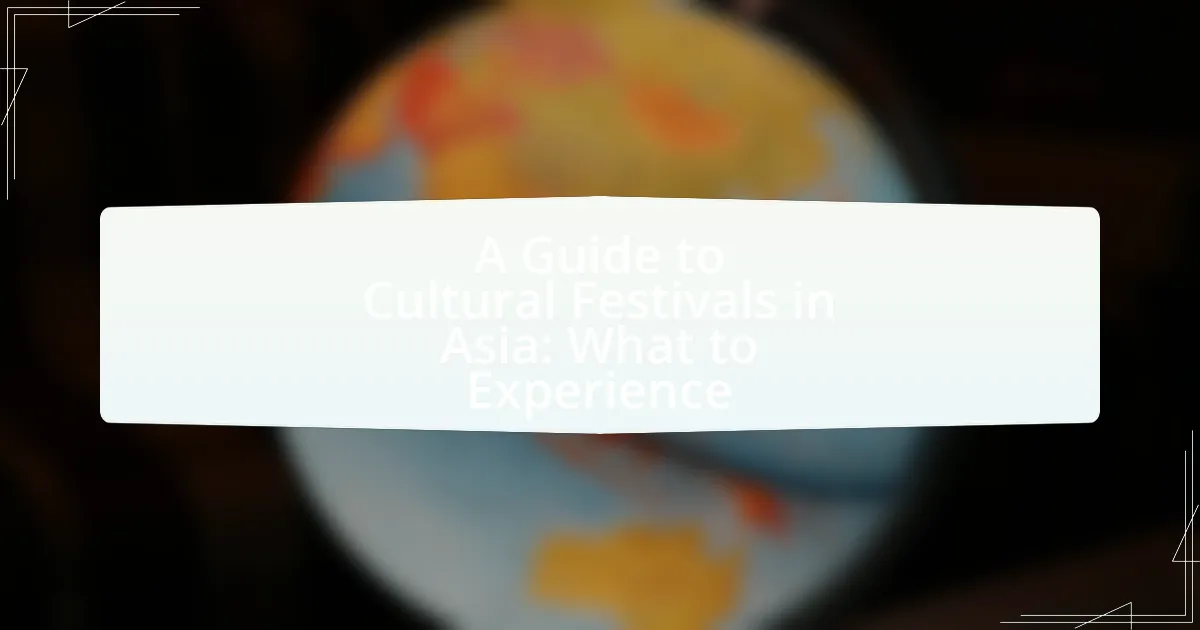Cultural festivals in Asia are dynamic events that highlight the continent’s rich diversity in traditions, arts, and customs. These festivals, such as Diwali in India and the Lantern Festival in Taiwan, encompass various elements including music, dance, food, and rituals, reflecting the unique heritage of different communities. The article explores how these festivals promote cultural preservation, foster community bonds, and provide significant economic benefits to local regions. It also outlines the various types of festivals, their cultural significance, and practical tips for travelers seeking to immerse themselves in these vibrant celebrations.

What are Cultural Festivals in Asia?
Cultural festivals in Asia are vibrant celebrations that showcase the diverse traditions, arts, and customs of various communities across the continent. These festivals often include music, dance, food, and rituals that reflect the unique heritage of each region. For example, the Diwali festival in India celebrates the victory of light over darkness, while the Chinese New Year features dragon dances and fireworks to usher in prosperity. Such events attract millions of participants and tourists, contributing significantly to local economies and cultural preservation.
How do Cultural Festivals reflect the diversity of Asian cultures?
Cultural festivals reflect the diversity of Asian cultures by showcasing unique traditions, languages, and artistic expressions from various ethnic groups. For instance, the Diwali festival in India highlights Hindu customs with its vibrant lights and rituals, while the Lunar New Year celebrated across multiple Asian countries emphasizes family reunions and traditional foods. Additionally, the diverse performances, such as traditional dances and music, during festivals like the Harbin Ice Festival in China or the Songkran Water Festival in Thailand, illustrate the rich cultural heritage and regional variations within Asia. These events not only celebrate local customs but also promote intercultural understanding and appreciation among different communities.
What are the key elements that define a cultural festival in Asia?
Cultural festivals in Asia are defined by several key elements: traditional rituals, local cuisine, artistic performances, and community participation. Traditional rituals often reflect the historical and spiritual significance of the festival, such as the Lunar New Year celebrations in China, which include dragon dances and family reunions. Local cuisine plays a vital role, as festivals often feature unique dishes that highlight regional flavors, like the street food at the Thai Songkran festival. Artistic performances, including music, dance, and theater, showcase cultural heritage, exemplified by the Balinese Kecak dance during the Ubud Writers and Readers Festival. Lastly, community participation is essential, as festivals foster social cohesion and collective identity, evident in the communal activities during the Diwali festival in India. These elements collectively create a vibrant and immersive experience that celebrates the rich cultural diversity of Asia.
How do traditions and customs influence these festivals?
Traditions and customs significantly shape the character and practices of cultural festivals in Asia. These elements dictate the rituals, performances, and communal activities that define each festival, ensuring that they reflect the historical and cultural heritage of the communities involved. For instance, the Diwali festival in India incorporates customs such as lighting oil lamps and exchanging sweets, which symbolize the victory of light over darkness and the importance of community bonds. Similarly, the Chinese New Year is influenced by traditions like family reunions and the giving of red envelopes, which are rooted in beliefs about prosperity and good fortune. These customs not only enhance the festive atmosphere but also serve to educate younger generations about their cultural identity and values, thereby preserving these traditions for the future.
Why are Cultural Festivals important for local communities?
Cultural festivals are important for local communities because they foster social cohesion and promote cultural heritage. These events bring together diverse groups, enhancing community bonds and encouraging participation in shared traditions. For instance, festivals like Diwali in India or the Lantern Festival in Taiwan attract thousands, stimulating local economies through tourism and commerce. According to a study by the National Endowment for the Arts, cultural events can increase community engagement and pride, leading to stronger local identities.
How do these festivals contribute to cultural preservation?
Cultural festivals contribute to cultural preservation by actively showcasing and celebrating traditional practices, rituals, and art forms that define a community’s identity. These festivals serve as platforms for intergenerational knowledge transfer, where older generations pass down customs, stories, and skills to younger participants, ensuring continuity of cultural heritage. For example, the annual Gion Matsuri in Kyoto, Japan, not only features traditional parades and performances but also involves local artisans who create intricate floats, thereby preserving craftsmanship that has been practiced for centuries. Additionally, festivals often attract tourism, which can lead to increased funding and support for cultural initiatives, further solidifying the importance of maintaining cultural traditions.
What economic benefits do Cultural Festivals bring to host regions?
Cultural festivals bring significant economic benefits to host regions by boosting local tourism, increasing revenue for businesses, and creating job opportunities. For instance, festivals attract visitors who spend money on accommodations, food, and entertainment, which stimulates the local economy. A study by the National Endowment for the Arts found that cultural events can generate up to $4 in economic activity for every $1 spent on the festival. Additionally, these events often lead to temporary job creation in sectors such as hospitality and retail, further enhancing the economic impact on the community.
What types of Cultural Festivals can be found in Asia?
Cultural festivals in Asia encompass a diverse range of types, including religious festivals, harvest festivals, traditional arts festivals, and music and dance festivals. For instance, Diwali in India is a prominent religious festival celebrating the victory of light over darkness, while the Lunar New Year is celebrated across various Asian countries, marking the beginning of the new year in the lunar calendar. Harvest festivals like the Pongal in Tamil Nadu, India, celebrate the harvest season, showcasing local traditions and agricultural practices. Additionally, traditional arts festivals such as the Gion Matsuri in Japan highlight cultural heritage through parades and performances, and music and dance festivals like the Bali Arts Festival in Indonesia promote local art forms and performances. These festivals reflect the rich cultural tapestry of Asia, showcasing its traditions, beliefs, and artistic expressions.
What are some examples of religious festivals in Asia?
Some examples of religious festivals in Asia include Diwali in India, Eid al-Fitr celebrated by Muslims across various countries, and the Chinese New Year observed in China and other regions. Diwali, known as the Festival of Lights, symbolizes the victory of light over darkness and is celebrated with fireworks, lamps, and sweets. Eid al-Fitr marks the end of Ramadan, the Islamic holy month of fasting, and is celebrated with communal prayers and feasting. The Chinese New Year, also known as Lunar New Year, involves family reunions, traditional foods, and various cultural performances, celebrating the arrival of spring and the new lunar calendar year.
How do seasonal festivals vary across different Asian countries?
Seasonal festivals in Asia vary significantly due to cultural, religious, and historical influences unique to each country. For example, in India, Diwali, the Festival of Lights, celebrates the victory of light over darkness and is marked by fireworks, sweets, and family gatherings, while Holi, the Festival of Colors, signifies the arrival of spring and involves throwing colored powders. In contrast, Japan celebrates Hanami, the cherry blossom festival, where people gather to appreciate the blooming sakura trees, reflecting a deep connection to nature. In Thailand, Songkran marks the traditional New Year with water fights symbolizing purification and renewal. These festivals illustrate the diverse ways Asian countries celebrate seasonal changes, rooted in their distinct traditions and beliefs.

What are the Most Famous Cultural Festivals in Asia?
The most famous cultural festivals in Asia include Diwali in India, the Lantern Festival in Taiwan, Songkran in Thailand, and the Cherry Blossom Festival in Japan. Diwali, celebrated by millions, symbolizes the victory of light over darkness and is marked by fireworks and the lighting of lamps. The Lantern Festival, which marks the end of the Lunar New Year celebrations, features colorful lantern displays and dragon dances. Songkran, the Thai New Year festival, is renowned for its water fights and cultural rituals. The Cherry Blossom Festival celebrates the blooming of sakura trees, attracting visitors to parks across Japan. Each of these festivals showcases unique cultural traditions and attracts significant local and international participation.
Which festivals are considered must-see events for travelers?
Must-see festivals for travelers in Asia include Diwali in India, the Lantern Festival in Taiwan, and the Songkran Water Festival in Thailand. Diwali, celebrated by millions, symbolizes the victory of light over darkness and features vibrant fireworks and colorful decorations. The Lantern Festival marks the end of the Lunar New Year celebrations in Taiwan, showcasing thousands of illuminated lanterns released into the sky. Songkran, the Thai New Year festival, is famous for its water fights, attracting tourists eager to participate in this unique cultural experience. Each of these festivals offers a rich cultural immersion, making them essential events for travelers.
What unique experiences do festivals like Diwali offer?
Festivals like Diwali offer unique experiences centered around themes of light, community, and cultural heritage. Diwali, known as the Festival of Lights, symbolizes the victory of light over darkness and good over evil, celebrated with vibrant decorations, fireworks, and the lighting of oil lamps called diyas. The festival fosters community bonding through shared rituals, such as family gatherings, feasting on traditional sweets, and exchanging gifts, which enhance social ties and cultural identity. Additionally, Diwali includes cultural performances, such as dance and music, that showcase regional traditions, enriching participants’ understanding of their heritage. The widespread practice of charitable giving during this time also emphasizes compassion and community support, making Diwali a multifaceted celebration that offers both personal and communal experiences.
How does the Lantern Festival celebrate Chinese culture?
The Lantern Festival celebrates Chinese culture by symbolizing the reunion of families and the welcoming of spring. This festival, which occurs on the 15th day of the first lunar month, features the display of colorful lanterns, traditional lion dances, and the solving of riddles written on lanterns, all of which reflect the rich heritage and communal spirit of Chinese society. Historically, the festival dates back over 2,000 years, originating during the Han Dynasty, and has evolved to incorporate various regional customs and artistic expressions, reinforcing cultural identity and continuity.
What are the highlights of the Holi Festival in India?
The highlights of the Holi Festival in India include vibrant color throwing, festive music and dance, and communal feasting. During Holi, participants joyfully throw colored powders and water at each other, symbolizing the arrival of spring and the victory of good over evil. This celebration is marked by traditional songs and dances, creating a lively atmosphere. Additionally, families and friends come together to share sweets and special dishes, reinforcing social bonds. Holi is celebrated across India, with notable events in cities like Mathura and Vrindavan, where the festival has deep cultural significance and attracts large crowds.
How is Holi celebrated across different regions of India?
Holi is celebrated with distinct regional variations across India, reflecting local traditions and customs. In North India, particularly in Uttar Pradesh, the festival is marked by vibrant processions, singing, and dancing, especially in Mathura and Vrindavan, where it commemorates the divine love of Radha and Krishna. In Maharashtra, Holi is celebrated with the traditional practice of ‘puran poli’ and the throwing of colored powders, while in Gujarat, the festival includes folk dances like Garba and Dandiya. In West Bengal, the celebration is known as ‘Dol Jatra,’ where idols of Krishna are carried in processions and people play with colors. Each region incorporates unique rituals and culinary specialties, showcasing the diversity of Holi celebrations across India.
What cultural significance does Holi hold for participants?
Holi holds significant cultural importance for participants as it symbolizes the arrival of spring and the victory of good over evil. This festival fosters community bonding, as people come together to celebrate with vibrant colors, music, and dance, breaking social barriers and promoting unity. Historically, Holi is linked to various Hindu legends, such as the story of Prahlad and Holika, which reinforces its themes of resilience and devotion. The celebration also encourages forgiveness and the renewal of relationships, making it a vital aspect of social and cultural identity for those who partake in the festivities.
What makes the Songkran Festival in Thailand unique?
The Songkran Festival in Thailand is unique due to its nationwide water fights, which symbolize the cleansing of sins and the welcoming of the Thai New Year. This festival, celebrated annually from April 13 to 15, involves people splashing water on each other as a form of purification and renewal. The tradition is rooted in Buddhist customs, where water is poured over Buddha statues and the hands of elders as a sign of respect and to seek blessings. Additionally, Songkran features vibrant parades, traditional music, and cultural performances, making it a lively celebration that attracts both locals and tourists.
How do locals and tourists participate in Songkran celebrations?
Locals and tourists participate in Songkran celebrations primarily through water fights, religious ceremonies, and cultural events. During the festival, which marks the Thai New Year, participants engage in water splashing as a symbolic act of cleansing and renewal. Locals often prepare by gathering in public spaces, while tourists join in the festivities by purchasing water guns and joining organized events. Additionally, many people visit temples to pour water over Buddha statues and engage in merit-making activities, reflecting the festival’s spiritual significance. The widespread participation is evident, as Songkran attracts millions of visitors each year, with estimates indicating that over 10 million tourists partake in the celebrations, highlighting its importance as a cultural event in Thailand.
What traditions are associated with the Songkran Festival?
The traditions associated with the Songkran Festival primarily include water pouring, temple visits, and the building of sand pagodas. Water pouring symbolizes the washing away of sins and bad luck, while temple visits involve paying respects to Buddha statues and participating in merit-making activities. Building sand pagodas, often decorated with flowers, represents the return of the Buddha to his home after the rainy season. These practices are rooted in the festival’s origins as a celebration of the Thai New Year and reflect the cultural significance of purification and renewal in Thai society.

How to Experience Cultural Festivals in Asia?
To experience cultural festivals in Asia, travelers should plan their visits around specific festival dates and locations, as many festivals are tied to local traditions and seasonal events. For instance, the Chinese New Year, celebrated across various Asian countries, typically occurs between late January and mid-February, showcasing vibrant parades and traditional performances. Additionally, participating in local customs, such as wearing traditional attire or engaging in festival activities, enhances the experience. Researching festivals like Diwali in India or Songkran in Thailand can provide insights into unique cultural practices, allowing for deeper engagement. Engaging with local communities during these events fosters authentic experiences and understanding of the cultural significance behind each festival.
What tips should travelers consider when attending these festivals?
Travelers should consider planning their itinerary well in advance when attending cultural festivals in Asia. This includes researching the festival dates, local customs, and any specific attire required for participation. For instance, festivals like Diwali in India or Songkran in Thailand have unique traditions that enhance the experience. Additionally, travelers should book accommodations early, as hotels can fill up quickly during peak festival times. According to a report by the Asia Pacific Tourism Association, festival attendance can increase local tourism by up to 30%, highlighting the importance of early planning. Lastly, being respectful of local customs and engaging with the community can enrich the festival experience, fostering a deeper understanding of the culture.
How can travelers respect local customs during festivals?
Travelers can respect local customs during festivals by researching and understanding the specific traditions and practices of the culture they are visiting. Engaging with local communities, participating in rituals respectfully, and adhering to dress codes are essential actions. For example, in many Asian festivals, wearing traditional attire is encouraged, which shows appreciation for the culture. Additionally, being mindful of local etiquette, such as observing silence during ceremonies or refraining from taking photos in restricted areas, demonstrates respect. These practices are supported by cultural studies that emphasize the importance of cultural sensitivity in fostering positive interactions between travelers and local communities.
What are the best ways to immerse oneself in the festival atmosphere?
To immerse oneself in the festival atmosphere, actively participate in the events and engage with the local culture. This includes attending traditional performances, trying local foods, and joining in on community activities, which enhances the overall experience. For instance, during the Diwali festival in India, participating in lighting diyas and sharing sweets with neighbors fosters a sense of belonging and connection to the celebration. Engaging with local artisans and learning about their crafts, as seen in the Lantern Festival in Taiwan, also deepens the understanding of cultural significance.
What practical advice is there for planning a trip around a festival?
To effectively plan a trip around a festival, start by researching the festival dates and location to ensure your travel aligns with the event. This involves checking the festival’s official website or reliable travel resources for accurate information on schedules and activities. Additionally, consider booking accommodations early, as hotels and hostels near the festival site often fill up quickly, especially during peak seasons. For instance, the Holi Festival in India attracts thousands of visitors, leading to high demand for nearby lodging. Lastly, familiarize yourself with local customs and transportation options to navigate the area efficiently, as this enhances your overall experience and ensures you don’t miss key festival events.
How can travelers find reliable information about festival dates and events?
Travelers can find reliable information about festival dates and events by consulting official tourism websites and local government resources. These platforms typically provide accurate and up-to-date information regarding festival schedules, locations, and any changes that may occur. For instance, the official tourism board of a specific country or region often lists major cultural events, ensuring that travelers access verified details. Additionally, reputable travel guides and apps, such as Lonely Planet or TripAdvisor, aggregate user-generated content and expert insights, further enhancing the reliability of the information.
What should travelers pack for attending cultural festivals in Asia?
Travelers should pack lightweight, breathable clothing, comfortable footwear, and culturally appropriate attire for attending cultural festivals in Asia. Lightweight clothing is essential due to the often warm and humid climates in many Asian countries, while comfortable footwear is necessary for walking and standing during long festival hours. Culturally appropriate attire, such as traditional garments or modest clothing, is important to respect local customs and traditions, as many festivals have specific dress codes. For example, in India, wearing traditional attire like a saree or kurta is encouraged during festivals like Diwali. Additionally, packing essentials like sunscreen, a reusable water bottle, and a small backpack can enhance the festival experience by ensuring comfort and convenience.
How can travelers ensure a memorable experience at cultural festivals?
Travelers can ensure a memorable experience at cultural festivals by actively engaging with local traditions and customs. Participating in activities such as traditional dances, workshops, or culinary experiences allows travelers to immerse themselves in the culture. For instance, attending the Holi festival in India offers the opportunity to join in the vibrant color celebrations, which are deeply rooted in local customs. Additionally, interacting with local residents and learning about their stories enhances the overall experience, as personal connections often lead to a deeper understanding of the cultural significance behind the festival.
What are some common pitfalls to avoid during festival visits?
Common pitfalls to avoid during festival visits include neglecting to plan ahead, which can lead to missing key events or experiencing overcrowding. Visitors often underestimate the importance of researching the festival schedule, local customs, and transportation options, resulting in confusion and frustration. Additionally, failing to stay hydrated and manage personal belongings can lead to discomfort and loss. According to a study by the International Journal of Event Management Research, 60% of festival-goers reported feeling overwhelmed due to lack of preparation, highlighting the necessity of advance planning to enhance the experience.
How can engaging with locals enhance the festival experience?
Engaging with locals enhances the festival experience by providing authentic insights and cultural context that enrich participation. Locals often share personal stories, traditions, and practices that are not available through official channels, allowing festival-goers to gain a deeper understanding of the event’s significance. For example, during the Diwali festival in India, interacting with residents can reveal unique family customs and local celebrations that differ from mainstream representations. This direct engagement fosters a sense of community and connection, making the experience more memorable and immersive.

Leave a Reply